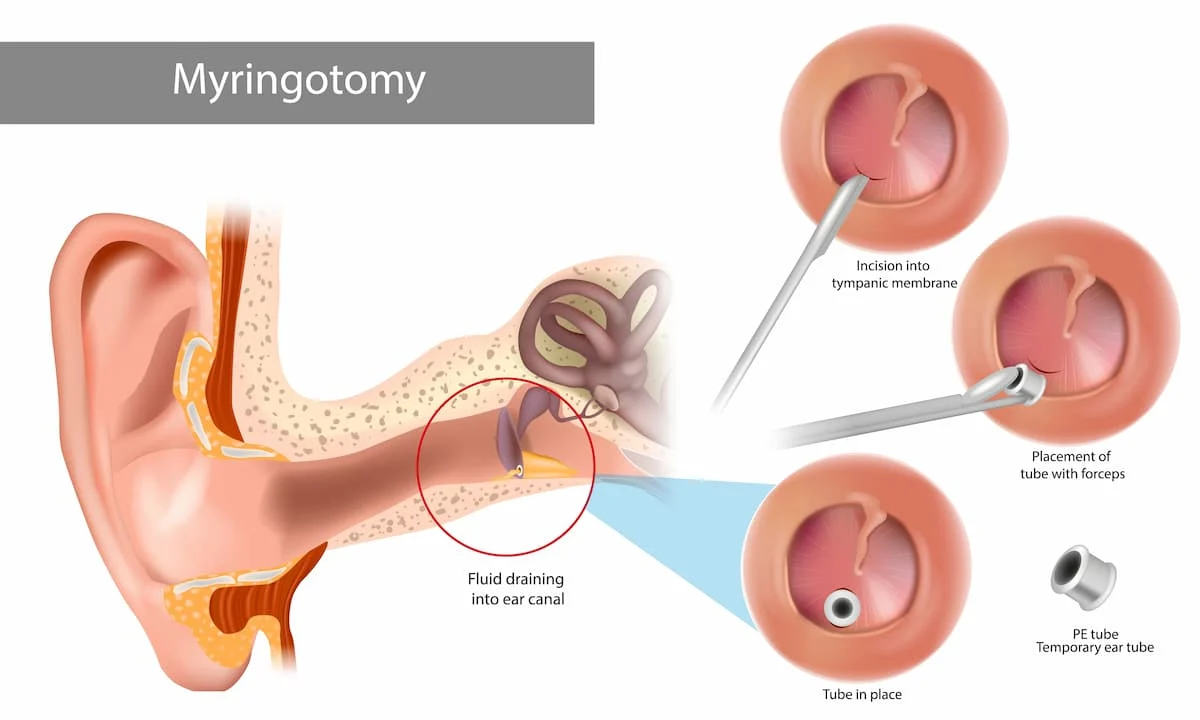All Departments
- Adenoidectomy
- Ear Infection
- Eardrum Surgery
- FESS ( Functional-Endoscopic-Sinus-Surgery)
- Mastoidectomy Surgery
- Myringotomy
- Nasal Polyps Surgery
- Septoplasty
- Sinus Surgery
- Stapedectomy
- Throat Surgery
- Thyroidectomy
- Tonsillectomy
- Tonsillectomy
- Turbinate Reduction
- Tympanoplasty
- Vocal Cord Surgery
Emergency Cases
917838450942
Myringotomy
Best Myringotomy surgery centers in India
One of India’s top and biggest suppliers of surgical care is Doxtreat. It collaborates with some of the top ENT facilities in India to offer all of its patients cutting-edge ear, nose, and throat care at reasonable costs. Furthermore, Doxtreat has a group of highly skilled ENT doctors that carry out complex ear surgeries including tympanoplasty, myringotomy, tympanostomy, etc. without the patient experiencing any difficulties or hearing loss.
Doxtreat also offers the patient additional support services like full insurance and hospital documentation assistance, simple payment methods like cost-free EMI, etc. Additionally, it offers the patient cab service for pick-up and drop-off from the clinic on the day of operation as well as free meals while they are in the hospital.

What happens during Myringotomy?
During a myringotomy, a surgeon will make a small incision in the eardrum using a small blade or laser. This incision allows any fluid or pus that has accumulated in the middle ear to drain out, which can relieve pressure and reduce pain.
After making the incision, the surgeon may insert a small tube into the opening. The tube is made of plastic, metal, or other materials, and helps to keep the incision open, allowing continued drainage of fluid from the middle ear. The tube can also help equalize pressure on both sides of the eardrum, which can improve hearing.
Myringotomy is typically performed under general anesthesia, so the patient will be unconscious during the procedure. It usually takes only a few minutes to perform, and patients can usually go home the same day. After the procedure, the patient may experience some discomfort or ear drainage, but this usually resolves within a few days.
The small tube inserted during the procedure will eventually fall out on its own, usually after several months. If it does not fall out on its own, it may need to be removed by a doctor.

How to prepare for a Myringotomy?
During a myringotomy, a surgeon will make a smIf you or your child are scheduled to undergo a myringotomy surgery, there are several things you can do to prepare:
- Consult with your doctor: Talk to your doctor about any medications you or your child are taking, including over-the-counter medications and supplements. Your doctor may ask you to stop taking certain medications before the surgery.
- Fast before the surgery: Your doctor will likely ask you or your child to avoid eating or drinking anything for several hours before the surgery. This is to prevent nausea and vomiting during the procedure.
- Arrange for transportation: Because the surgery is usually performed under general anesthesia, you or your child will not be able to drive home after the procedure. Make sure you have arranged for someone to drive you or your child home.
- Follow instructions: Your doctor will provide you with specific instructions for preparing for the surgery, such as when to stop eating and drinking, when to arrive at the hospital, and what to expect during the procedure. It’s important to follow these instructions carefully to ensure the best possible outcome.

What to expect after a Myringotomy?
After a myringotomy procedure, it is normal to experience some discomfort and mild pain for a few days. The following are some of the things you or your child may expect after the procedure:
- Ear drainage: There may be some drainage from the ear, which may be clear or slightly bloody. This is normal and usually lasts for a few days.
- Pain or discomfort: Pain and discomfort in the ear is common after the procedure, but it can usually be managed with over-the-counter pain relievers such as acetaminophen or ibuprofen.
- Dizziness: Some people may experience dizziness or balance problems after the procedure. This is usually temporary and resolves within a few days.
- Activity restrictions: Your doctor may recommend avoiding activities such as swimming or diving for a few weeks after the procedure.
- Follow-up appointments: You or your child will need to attend a follow-up appointment with the doctor to check on the healing progress and to remove the ear tube if necessary.

Which tips should the patient follow to improve their recovery?
Here are some tips to aid in your recovery after undergoing myringotomy surgery:
- Following the surgery, you will have a bandage in your ear to absorb any drainage. Refrain from getting the bandage wet, and over the next 2-3 days, the drainage should decrease gradually.
- Change your gauze on a regular basis to prevent infection at the site of the surgery.
- Take your medications as directed by your doctor. If ear drops have been prescribed, make sure to use them as recommended by your ENT specialist. Typically, patients are prescribed antibiotic ear drops after surgery to reduce the risk of infection.
- If water accidentally enters your ear, gently wipe it away and keep track of any drainage. A small amount of drainage is normal, but if it persists beyond 3 days, consult your doctor.
- Check with your ENT surgeon before resuming showers and baths. If you choose to swim or bathe, use ear plugs to keep water out of your ear. Do not immerse your head underwater until you have received clearance from your ENT specialist.
- During the recovery period, avoid cleaning your ears with a Q-tip or any other similar object. Also, consult your doctor before inserting anything in your ear.
- If you notice any signs of infection, such as fever and chills, redness, swelling, increasing pain, excessive bleeding, or discharge from the ear, contact your doctor right away. Other symptoms to watch out for include drainage from the ear that lasts more than 3 days after surgery, no improvement in hearing, cough, shortness of breath, chest pain, severe nausea, or vomiting.

When is a Myringotomy required?
Myringotomy is a surgical procedure performed on patients with fluid buildup in the middle ear canal, which is usually caused by a condition called otitis media with effusion. When fluid accumulates in the middle ear, it can interfere with the function of the eustachian tube and cause balance problems.
Myringotomy may be necessary for various ear conditions, including:
- Recurrent otitis media (middle ear infections)
- Ear bleeding due to trauma or eardrum perforation
- Difficulty in hearing or muffled hearing
- Eustachian tube dysfunction with associated hearing loss, vertigo, and tinnitus
- Severe retraction pocket in the tympanic membrane
- Difficulty in maintaining balance
- Ear barotrauma, which is a sudden change in pressure in the air surrounding the ear canal – particularly if it happens frequently due to activities such as flying, diving, or hyperbaric chamber treatment.

What are the complications associated with a Myringotomy?
Myringotomy is generally a safe procedure, but as with any surgery, there are risks and potential complications. Some of the possible complications associated with myringotomy include:
- Infection: There is a risk of infection with any surgical procedure, including myringotomy. Antibiotics may be prescribed to reduce the risk of infection.
- Bleeding: The incision made during myringotomy may cause bleeding. In most cases, the bleeding stops on its own, but additional treatment may be needed in rare cases.
- Perforation: There is a risk of the eardrum tearing during the procedure. In most cases, the perforation heals on its own, but sometimes additional treatment is required.
- Tube displacement: Ear tubes placed during myringotomy may become displaced or fall out, requiring further treatment.
- Scarring: In rare cases, the incision made during myringotomy may result in scarring that affects hearing.
- Tinnitus: Some people may experience ringing in the ears (tinnitus) after the procedure.
- Dizziness: Some people may experience dizziness or balance problems after the procedure, but this usually resolves within a few days.
How can Myringotomy benefit you?
Myringotomy can provide several benefits for individuals who have certain ear conditions. The procedure involves making a small incision in the eardrum to drain fluid that has accumulated in the middle ear, which can provide the following benefits:
- Improved hearing: When fluid builds up in the middle ear, it can cause hearing loss. By draining the fluid, myringotomy can improve hearing.
- Relief of ear pain and pressure: Fluid build-up in the middle ear can cause pain and pressure in the ear. Myringotomy can relieve these symptoms by allowing the fluid to drain.
- Reduced risk of recurrent infections: In some cases, chronic or recurrent ear infections may occur due to fluid build-up in the middle ear. Myringotomy can reduce the risk of these infections by allowing fluid to drain and preventing its build-up.
- Improved balance: For some people, fluid build-up in the middle ear can affect balance. By draining the fluid, myringotomy can improve balance.
- Improved quality of life: For individuals who experience chronic or recurrent ear problems, myringotomy can provide relief and improve their overall quality of life.

